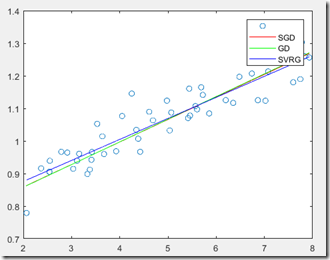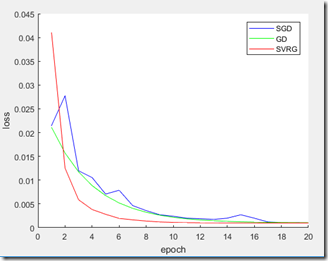梯度下降、随机梯度下降、方差减小的梯度下降(matlab实现)
梯度下降代码:
function [ theta, J_history ] = GradinentDecent( X, y, theta, alpha, num_iter )
m = length(y);
J_history = zeros(20, 1);
i = 0;
temp = 0;
for iter = 1:num_iter
temp = temp +1;
theta = theta - alpha / m * X' * (X*theta - y);
if temp>=100
temp = 0;
i = i + 1;
J_history(i) = ComputeCost(X, y, theta);
end
end
end
随机梯度下降代码:
function [ theta,J_history ] = StochasticGD( X, y, theta, alpha, num_iter )
m = length(y);
J_history = zeros(20, 1);
temp = 0;
n = 0;
for iter = 1:num_iter
temp = temp + 1;
index = randi(m);
theta = theta -alpha * (X(index, :) * theta - y(index)) * X(index, :)';
if temp>=100
temp = 0;
n = n + 1;
J_history(n) = ComputeCost(X, y, theta);
end
end
end
方差减小的梯度下降(SVRG):
function [ theta_old, J_history ] = SVRG( X, y, theta, alpha )
theta_old = theta;
n = length(y);
J_history = zeros(20,1);
m = 2 * n;
for i = 1:20
theta_ = theta_old;
Mu = 1/n * X' * (X*theta_ - y);
theta_0 = theta_;
for j = 1:m
index = randi(n);
GD_one = (X(index, :) * theta_0 - y(index)) * X(index, :)';
GD_ = (X(index, :) * theta_ - y(index)) * X(index, :)';
theta_t = theta_0 - alpha * (GD_one - GD_ + Mu);
theta_0 = theta_t;
end
J_history(i) = ComputeCost(X, y, theta_t);
theta_old = theta_t;
end
end
损失函数:
function J = ComputeCost( X, y, theta )
m = length(y);
J = sum((X*theta - y).^2) / (2*m);
end
主程序代码:
%% clean workspace
clc;
clear;
close all;
%% plot data
fprintf('plot data... \n');
X = load('ex2x.dat');
y = load('ex2y.dat');
m = length(y);
figure;
plot(X,y,'o');
%% gradient decent
fprintf('Runing gradient decent... \n');
X = [ones(m,1),X];
theta_SGD = zeros(2, 1);
theta_GD = zeros(2, 1);
theta_SVRG = zeros(2, 1);Iteration = 2000;
alpha = 0.015;
alpha1 = 0.025;[theta ,J]= StochasticGD(X, y, theta_SGD, alpha, Iteration);
[theta1 ,J1]= GradinentDecent(X, y, theta_GD, alpha, Iteration);
[theta2 ,J2]= SVRG(X, y, theta_SVRG, alpha1);fprintf('SGD: %f %f\n',theta(1),theta(2));
fprintf('GD: %f %f\n',theta1(1),theta1(2));
fprintf('SVRG: %f %f\n',theta2(1),theta2(2));hold on;
plot(X(:, 2), X*theta, 'r-');
plot(X(:, 2), X*theta1, 'g-');
plot(X(:, 2), X*theta2, 'b-');
legend('','SGD','GD','SVRG');x_j = 1:1:20;
figure;
hold on;
plot(x_j, J, 'b-');
plot(x_j, J1, 'g-');
plot(x_j, J2, 'r-');
legend('SGD','GD','SVRG');
xlabel('epoch')
ylabel('loss')
实验结果:


梯度下降、随机梯度下降、方差减小的梯度下降(matlab实现)的更多相关文章
- 梯度下降算法对比(批量下降/随机下降/mini-batch)
大规模机器学习: 线性回归的梯度下降算法:Batch gradient descent(每次更新使用全部的训练样本) 批量梯度下降算法(Batch gradient descent): 每计算一次梯度 ...
- 吴恩达机器学习笔记6-梯度下降II(Gradient descent intuition)--梯度下降的直观理解
在之前的学习中,我们给出了一个数学上关于梯度下降的定义,本次视频我们更深入研究一下,更直观地感受一下这个算法是做什么的,以及梯度下降算法的更新过程有什么意义.梯度下降算法如下: 描述:对
- 梯度下降&随机梯度下降&批梯度下降
梯度下降法 下面的h(x)是要拟合的函数,J(θ)损失函数,theta是参数,要迭代求解的值,theta求解出来了那最终要拟合的函数h(θ)就出来了.其中m是训练集的记录条数,j是参数的个数. 梯 ...
- 梯度下降优化算法综述与PyTorch实现源码剖析
现代的机器学习系统均利用大量的数据,利用梯度下降算法或者相关的变体进行训练.传统上,最早出现的优化算法是SGD,之后又陆续出现了AdaGrad.RMSprop.ADAM等变体,那么这些算法之间又有哪些 ...
- NN优化方法对照:梯度下降、随机梯度下降和批量梯度下降
1.前言 这几种方法呢都是在求最优解中常常出现的方法,主要是应用迭代的思想来逼近.在梯度下降算法中.都是环绕下面这个式子展开: 当中在上面的式子中hθ(x)代表.输入为x的时候的其当时θ參数下的输出值 ...
- 深度学习必备:随机梯度下降(SGD)优化算法及可视化
补充在前:实际上在我使用LSTM为流量基线建模时候,发现有效的激活函数是elu.relu.linear.prelu.leaky_relu.softplus,对应的梯度算法是adam.mom.rmspr ...
- batch、随机、Mini-batch梯度下降
batch梯度下降: 对所有m个训练样本执行一次梯度下降,每一次迭代时间较长: Cost function 总是向减小的方向下降. 随机梯度下降: 对每一个训练样本执行一次梯度下降,但是丢失了向量化带 ...
- L20 梯度下降、随机梯度下降和小批量梯度下降
airfoil4755 下载 链接:https://pan.baidu.com/s/1YEtNjJ0_G9eeH6A6vHXhnA 提取码:dwjq 梯度下降 (Boyd & Vandenbe ...
- [Machine Learning] 梯度下降(BGD)、随机梯度下降(SGD)、Mini-batch Gradient Descent、带Mini-batch的SGD
一.回归函数及目标函数 以均方误差作为目标函数(损失函数),目的是使其值最小化,用于优化上式. 二.优化方式(Gradient Descent) 1.最速梯度下降法 也叫批量梯度下降法Batch Gr ...
随机推荐
- 解决网卡无法自动获取ip的办法
解决网卡无法自动获取IP址的方法 为了省钱或者一户多机,很多人都购买宽带路由器共享上网.在架设路由上网的时候,有些“师傅”可能不懂或是偷懒,开启了宽带路由器的DHCP( Dynami ...
- 乘风破浪:LeetCode真题_004_Median of Two Sorted Arrays
乘风破浪:LeetCode真题_004_Median of Two Sorted Arrays 一.前言 说到算法,最难的就是一些需要通过分析得到一些递推公式或者有用的结论,进而用来解决问题的方法了. ...
- github发布静态页面
github发布静态页面:https://wangc1993.github.io/2019/01/07/2/
- [T-ARA][넘버나인][No.9]
歌词来源: 넘버나인 (No.9):http://music.163.com/#/song?id=27808770 넘버나인(Club ver.):http://music.163.com/#/son ...
- Linux中安装Nginx
1.安装编译文件及库文件 yum -y install make zlib zlib-devel gcc-c++ libtool openssl openssl-devel 2.安装PCRE,Ngi ...
- java BigDecimal解析及注意事项
BigDecimal简介 JDK文档(中文)中的解释如下: 不可变的.任意精度的有符号十进制数.BigDecimal 由任意精度的整数非标度值 和 32 位的整数标度 (scale) 组成.如果为零或 ...
- 1053. [HAOI2007]反素数ant【DFS+结论】
Description 对于任何正整数x,其约数的个数记作g(x).例如g(1)=1.g(6)=4.如果某个正整数x满足:g(x)>g(i) 0<i<x ,则称x为反质数.例如,整数 ...
- yii2.0 rules 规则中场景验证字段
除了app场景以外的其他场景都验证uid字段['uid', 'required','except'=>'app', 'message' => '参数错误'], 只有app场景验证uid字段 ...
- Java反序列化之Jackson-databind
这个洞的cve编号:CVE-2017-17485,漏洞环境就如第一个链接那样,jdk需要在jdk 1.8以上. 先看一下Jackson-databind的用法,说白了就是将json转换成对象. tes ...
- 到底什么是dp思想(内含大量经典例题,附带详细解析)
期末了,通过写博客的方式复习一下dp,把自己理解的dp思想通过样例全部说出来 说说我所理解的dp思想 dp一般用于解决多阶段决策问题,即每个阶段都要做一个决策,全部的决策是一个决策序列,要你求一个 最 ...
